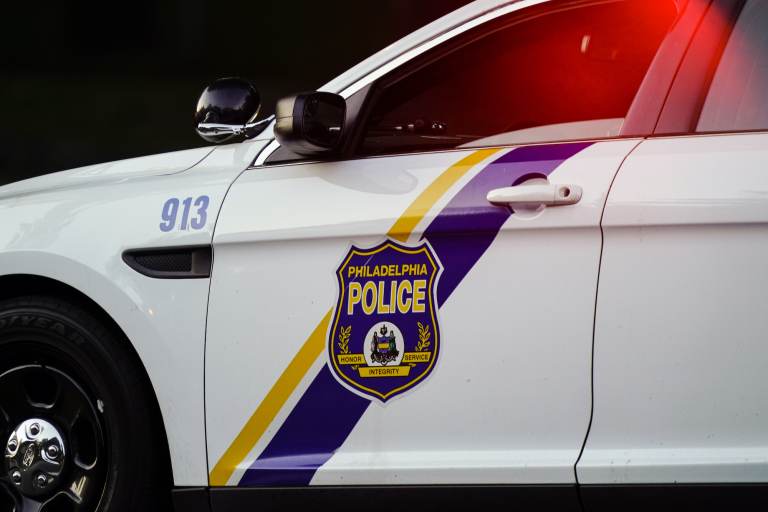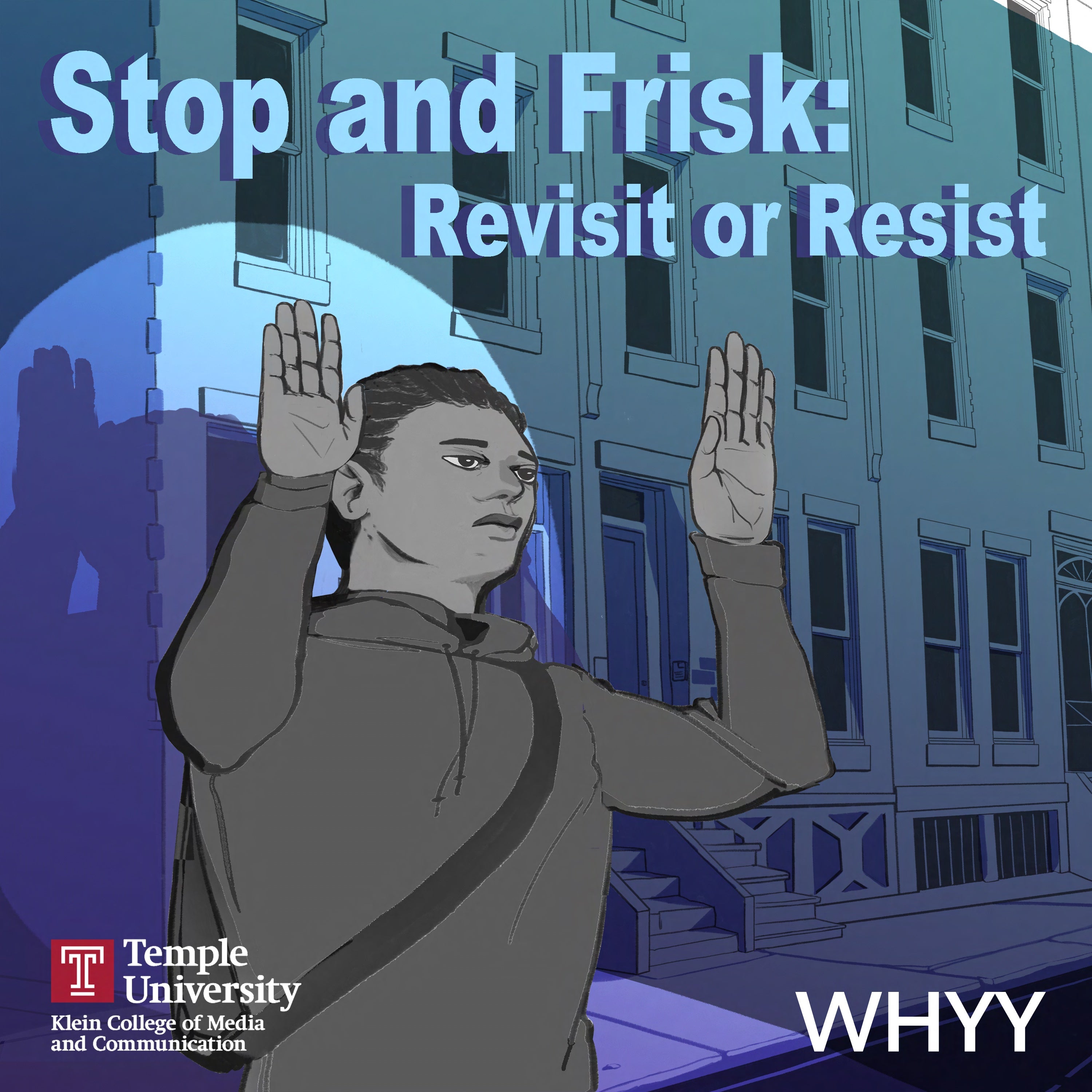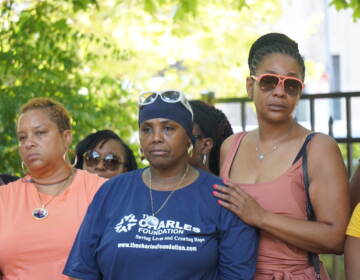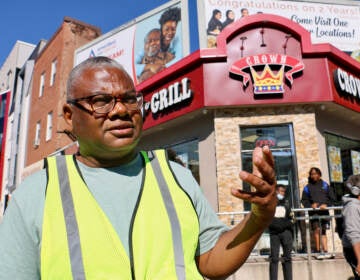Understanding the stop and frisk debate in Philadelphia, in 5 charts
In the midst of Philadelphia’s ongoing gun violence crisis, some people are asking whether the controversial policing practice stop and frisk is part of the answer.

File photo: Shown is a police vehicle in Philadelphia, Thursday, June 24, 2021. (AP Photo/Matt Rourke)
This story is from Stop and Frisk, a podcast production from WHYY News and Temple University’s Logan Center for Urban Investigative Reporting
Find it on Apple Podcasts, Spotify, or wherever you get your podcasts.
How do you feel about stop and frisk (and policing more broadly) as an answer to Philly’s gun violence crisis? Get in touch.
From New Year’s Day to Halloween, the city of Philadelphia lost at least 439 people, according to city data. That means on a more-than-once-a-day basis someone was killed—many to gunfire—and many more were left mourning.
Most of the shooters, and most of the victims, are Black men between ages 18 and 30. In about 18% of incidents, it’s tied to the drug trade. More than half the time, it starts with an argument, according to the City’s 100 Shooting Review Committee report. Released earlier this year, the report was part of a multi-agency effort to address increasing homicides and gun violence.
The crisis has led some city leaders and community members to reconsider the idea of “stop and frisk,” a decades-old policy that gives police officers discretion to stop anyone they believe has committed, is committing or is about to commit a crime, and to frisk that person if they suspect they’re armed. Philadelphians can learn more about their legal rights during a stop online.
Some residents feel that ramping up policing in neighborhoods affected by gun violence could restore a sense of consequences and deter crime. Others are worried that increased police presence will only lead to violent encounters between officers and Black residents, especially young Black men.
Five key takeaways from the stop and frisk debate:
- This isn’t the first time there’s been a spike in homicides and gun violence.
- Stop and frisk was used frequently by police, until a lawsuit spurred experts to reexamine and monitor the practice.
- Black Philadelphians are disproportionately stopped and frisked compared to other racial groups — even in a city that’s 40% Black.
- The number of legal guns on the street surged 620% from 2019 to 2020, but during the second half of 2019 police seized weapons just during 1% of all stop and frisk encounters.
- The number of women and children killed by gun violence is growing.
Listen to the “Stop and Frisk: Revisit or Resist” podcast to learn more about the discussion.
1. Homicides are up, but it’s not the first time
About 15 years ago, homicides in Philadelphia were on a fairly steady decline. Homicides dropped to a record-low 246 in 2013. But, by 2019 the homicide total was up to 356. Between 2019 and 2020 the city saw a 40% increase, and deaths have continued to mount. Last year, there were 562 murders, about 89% of committed with a firearm.
Philadelphia’s rise in gun violence since 2019 is consistent with other major metros across America. Experts say it’s the result of increased poverty and inequity during the COVID-19 pandemic, trauma from lockdown and from demonstrations against police brutality as well as an uptick in legal gun purchases and increase in illegal gun trafficking.
2. Stop and frisk was pervasive, until recently
There’s not a lot of data on the frequency of stops and frisks before 2014. But legal experts who were tracking it say there was a clear pattern of racial bias. In 2009, Black and Latino Philadelphians were the subject of 90% of stops, despite making up about 50% of the population at the time.
In 2010, the ACLU brought a federal class action lawsuit against the city of Philadelphia, which led to a 2011 settlement and creation of the Bailey Consent Decree. This agreement requires the Philadelphia Police Department to log all stops and frisks in an electronic database. The stops are logged by neighborhood, race, and gender.
Legal experts review the stops to assess whether they were conducted legally, with reasonable suspicion, and without racial bias. In the second half of 2019, 38% of frisks were made without reasonable suspicion, according to a report from ACLU of Pennsylvania.
When Mayor Jim Kenney took office in 2016, he promised to end stop and frisk (though later clarified he only meant buckling down on the policy’s racist implementation). That year, officers conducted about 411,000 pedestrian and vehicular stops — an average of 34,200 per month or roughly 1,100 per day.
The high number of stops persisted until the COVID-19 lockdown, when a pullback of police all but eliminated the practice. In June 2020, officers made just 1,100 stops citywide.
Homicides spiked in major cities nationwide during the pandemic, and experts say the trend is much more likely related to unemployment, racism, mental health and other systemic causes than it is to policing practices. Research on the strategy has not shown a causal effect between increasing the use of stop and frisk and decreasing crime. Some studies actually show the policy deteriorates trust in law enforcement and makes young people less willing to cooperate with investigations.
3. Black Philadelphians are being stopped the most
Since 2014, 69% of vehicular and pedestrian stops have been of Black Philadelphians, though this group makes up just 40% of the city’s population.
Stops are also much more frequent in largely Black neighborhoods, according to city data. During the last eight years, the 24th police district in North Philadelphia experienced about three times as many stops as the white, wealthier 9th district in Center City.
Since about 2015, about 79% of people arrested in Philadelphia shootings and about 80% of shooting victims have been Black, according to a recent report on gun violence. Those who support the return of stop and frisk believe it can be implemented equitably. But, opponents say that police officers’ racial bias will inevitably lead to disproportionate rates of unjustified stops and searches of Black men.
4. Philly’s gun supply is growing
Many supporters of stop and frisk see it as a way of getting illegal guns off the street. But in the second half of 2019, only 1% of searches resulted in the seizure of a weapon, according to an ACLU report.
The number of legal permits—open and concealed carry—issued in Philadelphia increased sevenfold from 2019 to 2020, from 7,400 to more than 54,000. Experts say that inevitably leads to more illegal gun trafficking.
Philadelphia police report they’ve been recovering more guns that have been illegally converted into automatic weapons.
There has been a slight increase in the effectiveness of stop and frisk when it comes to guns, though, according to David Rudovsky, the attorney who has been monitoring stops in accordance with the 2011 Bailey Agreement. In the first quarter of 2022 guns were confiscated in 5% of stops and 8% of frisks, said Rudovsky.
Philadelphia leaders disagree in their approaches to illegal guns. The police department has nearly doubled the number of arrests for firearm violations since 2014. But, gun crime convictions dropped during that time. In 2014, the district attorney’s office won convictions in 69% of illegal firearm possession cases. In 2019 that number dropped to 49%.
DA Larry Krasner has publicly said that he doesn’t believe confiscating illegal guns reduces shootings, and has insisted that law enforcement instead stay focused on solving crimes and getting known shooters off the street.
5. More Black women and children are being killed
Black women increasingly make up fatal and nonfatal shooting victims in Philadelphia. In 2022, 26 Black women died by gunfire, compared to nine in 2016, according to an analysis from Philadelphia Office of the Controller.
Many of the killings involving women and children are caused by stray bullets, according to community members and police reports. In August, drive-by shooters fired 96 bullets at the Shepard Recreation Center in West Philadelphia, injuring five bystanders.

Stop and Frisk: Revisit or Resist
WHYY is your source for fact-based, in-depth journalism and information. As a nonprofit organization, we rely on financial support from readers like you. Please give today.







